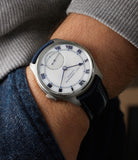Charles Frodsham & Co. is the oldest continuously trading maker of chronometers, with a history that goes all the way back to 1834. The brand was known for making marine chronometers, clocks, and pocket watches. While the name has been owned by different entities over the years, since 1997 it has been operated by Richard Stenning and Philip Whyte, with a workshop of seven watchmakers restoring timepieces and creating no more than 12 watches a year, just outside London. It represents a rare story of the continuity of a historic English watchmaking name.
This example of the Double Impulse Chronometer features a 42.2mm white gold case. It has a prominent stepped bezel, is brushed on top, has a facet, and is polished in profile. This meets the satinated midcase, which has the crown between 2 and 3 o’clock. This is done due to special constraints imposed by the nature of the movement. The only solution was to either have an off-centre subsidiary second or a slightly irregularly placed crown.
The satinated lugs are short, so when the watch is laid on a flat surface, they hover. This is reminiscent of cases made for Patek Philippe in the 1950s. The midcase has another distinct satinated layer that meets the hendecagon bezel of the display caseback. The back of the lugs features precious metal hallmarks, which include a crown stamp attesting to the fact that the case is made of white gold. It also features a leopard hallmark, which has been the sign of the Goldsmith’s Company in London since the 14th century.
The dial features a chapter of applied Roman hours, followed by a black chemin de fer of minutes, with blue, triangular junctions at five-minute intervals. Overlapping this is the prominent, recessed subsidiary second register, with a similar chapter running around it. Plying this section is a pointer-style seconds hand, with a prominent counterweight that ends in a teardrop shape. The hours hand ends in a similar motif, while the minutes hand is a simple pointer. While of significantly different visual weights, both hands are of the same length – their form is a reference to marine chronometers from the early 20th century. All the hands, as well as the applied Roman indices, are heat-hued to an even shade of rich purple. They provide high contrast against the moon-like white glow of the dial, made from durable ceramic zirconium oxide. It presents like enamel, while being far more stable. The brand mark as well as the minute and second tracks are applied by vapour deposition rather than printing. The lack of the historic cyphers, which are an option, gives the dial an altogether cleaner appearance.
The research to create the manually wound movement, which incorporated the double impulse escapement conceived by George Daniels, reportedly took 16 years. This is because previously it had only ever been fitted to considerably larger movements inside pocket watches. In fact, Frodsham consulted with the watchmaker Derek Pratt in an effort to miniaturise it to fit inside a wristwatch.
Visible under the large balance wheel, secured by a three-armed bridge, are the twin escapements. They have in between them a titanium détente, alternatingly engaging the escape wheels, and each has their own independent going trains and mainsprings powering them. This setup results in a very consistent delivery of power that is ideal for precise timekeeping. A balance-break safety device is incorporated to ensure the two barrels stay synchronised. It is for this reason that the movement doesn’t start working till it is fully wound; then it enjoys 40 hours of autonomy.
The finishing is of the sort expected in English watchmaking. Barring the balance bridge, which features bercé polishing, the bridge, with a butterfly-shaped cutout for the balance, features frosted English finishing. The edges of the bridge are finished precisely, if without anglage. The brand mark and ‘England’ seal are hand-engraved on the bridge. Under the balance is the engraved serial number, which continues the numbering sequence started by John Arnold in 1761. This was taken on by Charles Frodsham when he took control of Arnold and Son in 1843. As a result, the first Double Impulse Chronometers featured serial numbers in the 010780’s.
















































































































































































































